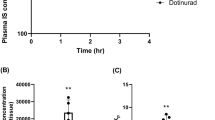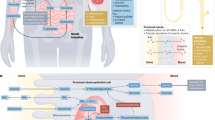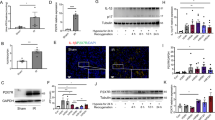Abstract
THE clearance of p-aminohippurate has become the standard method for the determination of effective renal plasma-flow, with the assumption that there is no conjugation of p-aminohippurate during its passage through the kidney from the blood to the urine. The metabolism of this substance in the body is considered to be similar to that of sulphanilamide which it resembles, namely, acetylation of the para amino group. p-Acetylaminohippurate and p-aminohippurate have similar clearances in the dog and man, so the former may be expected to depress maximal tubular excretion of the latter, but as neither p-acetylaminohippurate nor any metabolite in which the para amino group is substituted is estimated by the technique used for p-aminohippurate, conjugation at sites other than in the kidney should not affect the clearance of the latter. With sulphanilamide, conjugation occurred only in the liver of rabbits and rats, in the liver and spleen in cats, and not at all in the dog (cf. ref. 1). p-Aminohippurate itself was not conjugated by rabbit2 or dog3 kidney slices in vitro, although some conjugation was found with rat4 and guinea pig2 kidney slices. From the evidence available, Smith1 came to the conclusion that conjugation in the kidney did not occur to any significant extent in the species studied (rat, rabbit, cat, dog and man), although it has been suggested by others that conjugation could explain low clearances of p-aminohippurate with falling plasma concentrations in man5.
This is a preview of subscription content, access via your institution
Access options
Subscribe to this journal
Receive 51 print issues and online access
$199.00 per year
only $3.90 per issue
Buy this article
- Purchase on SpringerLink
- Instant access to full article PDF
Prices may be subject to local taxes which are calculated during checkout
Similar content being viewed by others
References
Smith, H. W., “The Kidney” (Oxf. Univ. Press, 1951).
Cross, R. J., and Taggart, J. V., Amer. J. Physiol., 161, 181 (1950).
Carhart, E., Koda, F., and Farah, A., Proc. Soc. Exp. Biol., N.Y., 85, 248 (1954).
Despopoulos, A., Amer. J. Physiol., 184, 396 (1956).
Newman, E., Kattus, A., Genecin, A., Genest, J., Calkins, E., and Murphy, J., Bull. Johns Hopkins, 84, 135 (1949).
Setchell, B. P., Biochem. J., 72, 265 (1959).
Poulsen, E., Kongelige Veterinaer-og Landbohøjskole Arsskrift, 97 (Copenhagen, 1957).
Munsick, R. A., Sawyer, W. H., and Van Dyke, H. B., Endocrinol., 63, 688 (1958).
McDonald, J., and McFarlane, W. V., Austral. J. Agric. Res., 9, 680 (1958).
Author information
Authors and Affiliations
Rights and permissions
About this article
Cite this article
SETCHELL, B., BLANCH, E. Conjugation of p-Aminohippurate by the Kidney and Effective Renal Plasma-flow. Nature 189, 230–231 (1961). https://doi.org/10.1038/189230b0
Issue date:
DOI: https://doi.org/10.1038/189230b0
This article is cited by
-
Suppression of tubular anion transport by an inhibitor of serum protein binding in uremia
Kidney International (1981)
-
Die Metabolisierung von p-Aminohippurat in Nieren von normalen Ratten und Ratten mit experimentellem Goldblatt-Hochdruck
Pfl�gers Archiv European Journal of Physiology (1972)



